四级英汉互译·英语作文·120字中华文化之二十四节气
二十四节气英语作文100词

二十四节气英语作文100词Title: The 24 Solar Terms.The 24 Solar Terms are an important part of traditional Chinese culture, representing the changes in weather, agricultural activities, and natural phenomena throughout the year. Each solar term is associated with specific activities and customs that reflect the characteristics of that time of year. For example, the Spring Equinox marks the beginning of spring when people celebrate the renewal of life and plant seeds for the upcoming harvest. The Dragon Boat Festival during the Grain Buds term is a time to honor the legendary poet Qu Yuan and enjoy delicious zongzi. By observing and celebrating the 24 Solar Terms, we can stay connected to the rhythms of nature and appreciate the beauty and harmony of the changing seasons.中文翻译:二十四节气是中国传统文化的重要组成部分,代表着一年中的天气变化、农业活动和自然现象。
关于二十四节气的英语作文80词
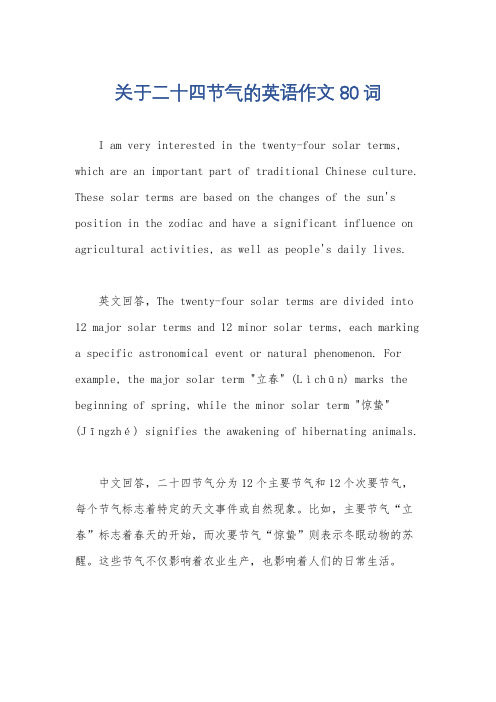
关于二十四节气的英语作文80词I am very interested in the twenty-four solar terms, which are an important part of traditional Chinese culture. These solar terms are based on the changes of the sun's position in the zodiac and have a significant influence on agricultural activities, as well as people's daily lives.英文回答,The twenty-four solar terms are divided into12 major solar terms and 12 minor solar terms, each markinga specific astronomical event or natural phenomenon. For example, the major solar term "立春" (Lìchūn) marks the beginning of spring, while the minor solar term "惊蛰"(Jīngzhé) signifies the awakening of hibernating animals.中文回答,二十四节气分为12个主要节气和12个次要节气,每个节气标志着特定的天文事件或自然现象。
比如,主要节气“立春”标志着春天的开始,而次要节气“惊蛰”则表示冬眠动物的苏醒。
这些节气不仅影响着农业生产,也影响着人们的日常生活。
二十四节气英文作文
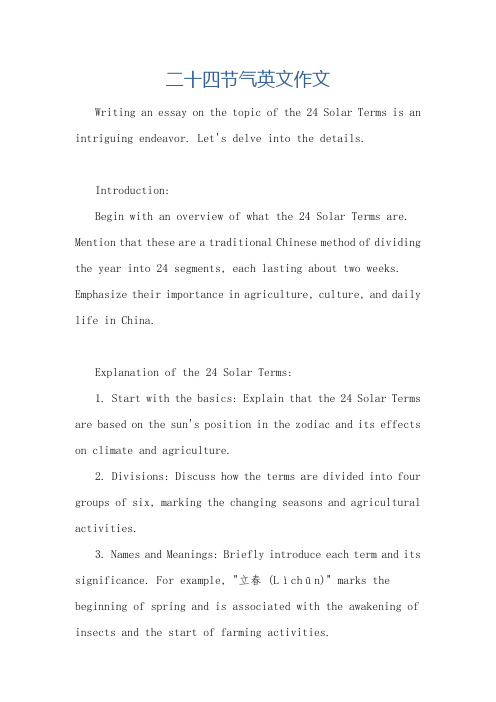
二十四节气英文作文Writing an essay on the topic of the 24 Solar Terms is an intriguing endeavor. Let's delve into the details.Introduction:Begin with an overview of what the 24 Solar Terms are. Mention that these are a traditional Chinese method of dividing the year into 24 segments, each lasting about two weeks. Emphasize their importance in agriculture, culture, and daily life in China.Explanation of the 24 Solar Terms:1. Start with the basics: Explain that the 24 Solar Terms are based on the sun's position in the zodiac and its effects on climate and agriculture.2. Divisions: Discuss how the terms are divided into four groups of six, marking the changing seasons and agricultural activities.3. Names and Meanings: Briefly introduce each term and its significance. For example, "立春 (Lìchūn)" marks the beginning of spring and is associated with the awakening of insects and the start of farming activities.4. Historical Context: Highlight the historical origins of the 24 Solar Terms, dating back to ancient China, and their integration into Chinese cultural practices and festivals.Cultural Significance:1. Agricultural Practices: Discuss how each Solar Term corresponds to specific agricultural activities, such as planting, harvesting, and seasonal rituals.2. Festivals and Traditions: Explore how the 24 Solar Terms are intertwined with traditional festivals and customs, such as Qingming Festival (清明节) and Mid-Autumn Festival (中秋节).3. Health and Lifestyle: Explain how the Solar Terms influence Chinese medicine, diet, and daily routines, such as adjusting diet and clothing according to seasonal changes.Modern Relevance:1. Continued Observance: Despite technological advancements, discuss how the 24 Solar Terms remain relevant in modern China, influencing agricultural practices, weather forecasting, and cultural celebrations.2. Global Influence: Highlight the growing interest in the24 Solar Terms beyond China, with other countries adopting similar systems or incorporating elements into their own cultures.3. Environmental Awareness: Touch upon how the Solar Terms serve as a reminder of the importance of environmental conservation and sustainable living in harmony with nature.Conclusion:Summarize the significance of the 24 Solar Terms in Chinese culture and their enduring relevance in today's world. Reflect on the lessons they offer about the interconnectedness of nature, culture, and human life.With this structure, you can craft a comprehensive and engaging essay on the topic of the 24 Solar Terms in English. If you need further elaboration on any aspect or have specific questions, feel free to ask!。
关于24节气的英语小作文
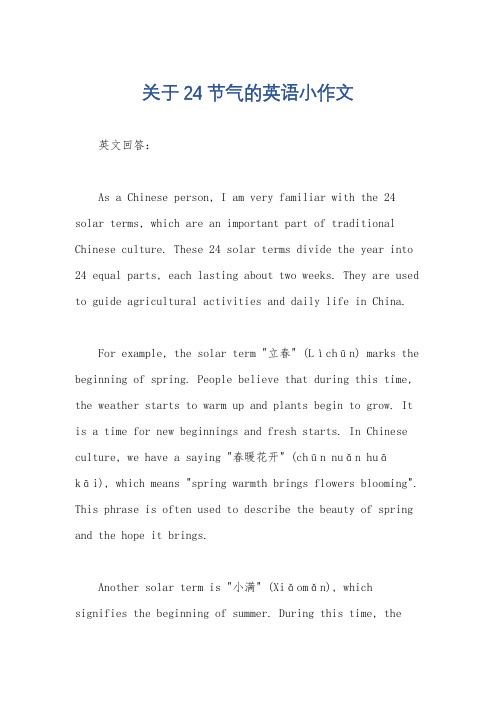
关于24节气的英语小作文英文回答:As a Chinese person, I am very familiar with the 24 solar terms, which are an important part of traditional Chinese culture. These 24 solar terms divide the year into 24 equal parts, each lasting about two weeks. They are used to guide agricultural activities and daily life in China.For example, the solar term "立春" (Lìchūn) marks the beginning of spring. People believe that during this time, the weather starts to warm up and plants begin to grow. It is a time for new beginnings and fresh starts. In Chinese culture, we have a saying "春暖花开" (chūn nuǎn huākāi), which means "spring warmth brings flowers blooming". This phrase is often used to describe the beauty of spring and the hope it brings.Another solar term is "小满" (Xiǎomǎn), which signifies the beginning of summer. During this time, thecrops are in full growth and the weather becomes hot. People often say "小满到,麦子黄" (Xiǎomǎn dào, màizi huáng), meaning "when Xiaoman arrives, the wheat turns yellow". This indicates that it is time to prepare for the upcoming harvest season.中文回答:作为一个中国人,我对24节气非常熟悉,它是中国传统文化的重要组成部分。
英语四级翻译:24节气
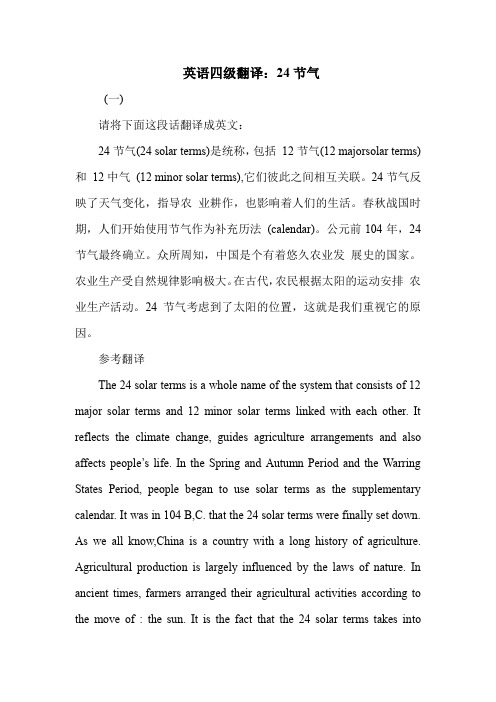
英语四级翻译:24节气(一)请将下面这段话翻译成英文:24节气(24 solar terms)是统称,包括12节气(12 majorsolar terms)和12中气(12 minor solar terms),它们彼此之间相互关联。
24节气反映了天气变化,指导农业耕作,也影响着人们的生活。
春秋战国时期,人们开始使用节气作为补充历法(calendar)。
公元前104年,24节气最终确立。
众所周知,中国是个有着悠久农业发展史的国家。
农业生产受自然规律影响极大。
在古代,农民根据太阳的运动安排农业生产活动。
24节气考虑到了太阳的位置,这就是我们重视它的原因。
参考翻译The 24 solar terms is a whole name of the system that consists of 12 major solar terms and 12 minor solar terms linked with each other. It reflects the climate change, guides agriculture arrangements and also affects people’s life. In the Spring and Autumn Period and the Warring States Period, people began to use solar terms as the supplementary calendar. It was in 104 B,C. that the 24 solar terms were finally set down. As we all know,China is a country with a long history of agriculture. Agricultural production is largely influenced by the laws of nature. In ancient times, farmers arranged their agricultural activities according to the move of : the sun. It is the fact that the 24 solar terms takes intoaccount the position of the sun that makes us attach importance to it.1.统称:即全称,可译为a whole/general name。
中国二十四节气英语作文
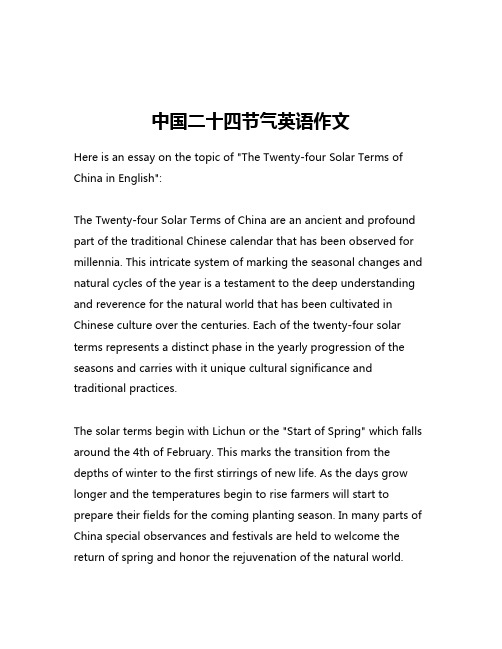
中国二十四节气英语作文Here is an essay on the topic of "The Twenty-four Solar Terms of China in English":The Twenty-four Solar Terms of China are an ancient and profound part of the traditional Chinese calendar that has been observed for millennia. This intricate system of marking the seasonal changes and natural cycles of the year is a testament to the deep understanding and reverence for the natural world that has been cultivated in Chinese culture over the centuries. Each of the twenty-four solar terms represents a distinct phase in the yearly progression of the seasons and carries with it unique cultural significance and traditional practices.The solar terms begin with Lichun or the "Start of Spring" which falls around the 4th of February. This marks the transition from the depths of winter to the first stirrings of new life. As the days grow longer and the temperatures begin to rise farmers will start to prepare their fields for the coming planting season. In many parts of China special observances and festivals are held to welcome the return of spring and honor the rejuvenation of the natural world.Following Lichun are Yushui or the "Rain Water" and Jingzhe or the "Waking of Insects" solar terms. These signal the arrival of the rainy spring season when the land is nourished by showers and the insects emerge from their winter slumber to resume their vital role in the ecosystem. Spring planting kicks into high gear during this time as farmers take advantage of the moist soil to sow their crops.The fourth solar term is Chunfen or the "Spring Equinox" which occurs around the 20th of March. This marks the point at which the day and night are of equal length and is seen as a time of balance and harmony in nature. Many cultures have rituals and celebrations to welcome the arrival of this equinoctial moment.Qingming or "Grave Sweeping Day" follows shortly after on the 4th or 5th of April. This is an important time for honoring one's ancestors by visiting and tending to their graves. It is also a popular time for outdoor excursions and enjoying the natural beauty of the spring landscape as it bursts into bloom.Guyu or the "Grain Rain" solar term in mid-April brings the vital spring rains that nourish the growing crops. Farmers work diligently during this period to ensure their plants receive the moisture they need to thrive. Traditional Chinese medicine also assigns special significance to the Guyu rains which are said to have restorative and cleansing properties.As spring transitions into summer the solar terms of Lixia or the "Start of Summer" Xiaoman or the "Grain Buds" and Mangzhong or the "Grain in Ear" occur. These mark the stages of crop maturation leading up to the summer harvest. Observances and festivals centered around these milestones help cultivate a deep appreciation for the natural cycles that sustain human life.Xiazhi or the "Summer Solstice" in late June is another pivotal solar term as it represents the longest day of the year. This auspicious moment is celebrated in many cultures around the world as a time of light vitality and renewal...。
有关24节气的英语作文高中
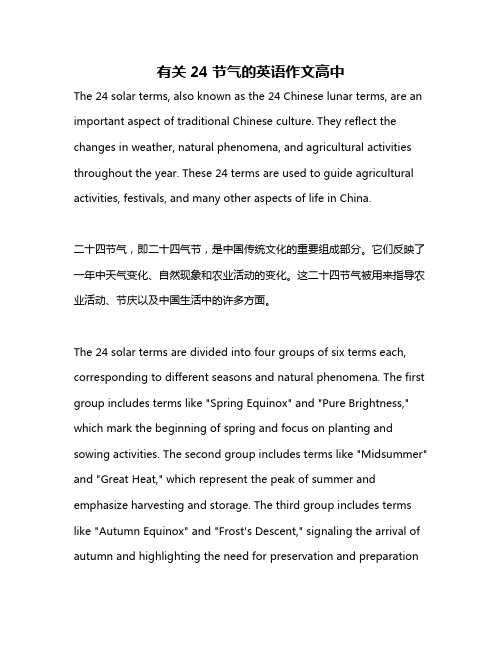
有关24节气的英语作文高中The 24 solar terms, also known as the 24 Chinese lunar terms, are an important aspect of traditional Chinese culture. They reflect the changes in weather, natural phenomena, and agricultural activities throughout the year. These 24 terms are used to guide agricultural activities, festivals, and many other aspects of life in China.二十四节气,即二十四气节,是中国传统文化的重要组成部分。
它们反映了一年中天气变化、自然现象和农业活动的变化。
这二十四节气被用来指导农业活动、节庆以及中国生活中的许多方面。
The 24 solar terms are divided into four groups of six terms each, corresponding to different seasons and natural phenomena. The first group includes terms like "Spring Equinox" and "Pure Brightness," which mark the beginning of spring and focus on planting and sowing activities. The second group includes terms like "Midsummer" and "Great Heat," which represent the peak of summer and emphasize harvesting and storage. The third group includes terms like "Autumn Equinox" and "Frost's Descent," signaling the arrival of autumn and highlighting the need for preservation and preparationfor the winter. The fourth group includes terms like "Winter Solstice" and "Greater Cold," indicating the depths of winter and the importance of taking care of oneself and others during this cold season.二十四节气被分为四组,每组包含六个节气,对应不同的季节和自然现象。
二十四节气的英语作文
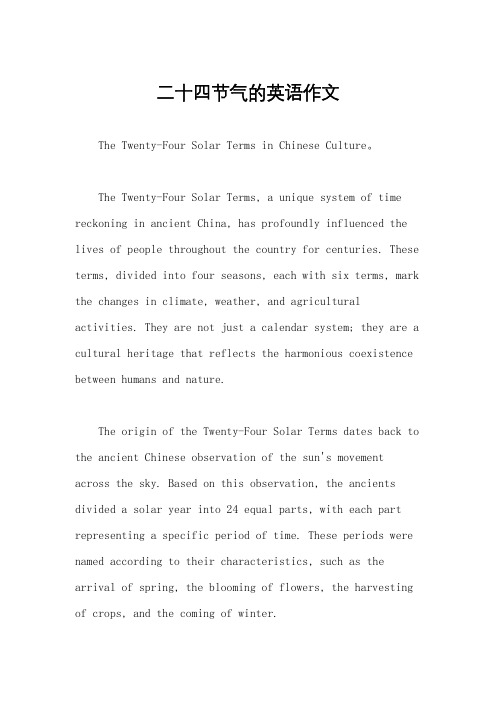
二十四节气的英语作文The Twenty-Four Solar Terms in Chinese Culture。
The Twenty-Four Solar Terms, a unique system of time reckoning in ancient China, has profoundly influenced the lives of people throughout the country for centuries. These terms, divided into four seasons, each with six terms, mark the changes in climate, weather, and agricultural activities. They are not just a calendar system; they are a cultural heritage that reflects the harmonious coexistence between humans and nature.The origin of the Twenty-Four Solar Terms dates back to the ancient Chinese observation of the sun's movement across the sky. Based on this observation, the ancients divided a solar year into 24 equal parts, with each part representing a specific period of time. These periods were named according to their characteristics, such as the arrival of spring, the blooming of flowers, the harvesting of crops, and the coming of winter.One of the most distinctive features of the Twenty-Four Solar Terms is its close relationship with agriculture. Since ancient times, Chinese farmers have relied on these terms to plan their planting, cultivation, and harvesting activities. For instance, the term "Spring Equinox" signals the beginning of spring, a time when farmers begin to sow their seeds. The "Autumn Equinox," on the other hand, marks the transition from summer to autumn, a period when crops。
中国二十四节气介绍作文英语

中国二十四节气介绍作文英语English: The 24 solar terms in the Chinese calendar are a unique system that divides the year into 24 segments based on the sun's position. Each solar term represents a specific astronomical event or natural phenomena, serving as a guide for agricultural activities, traditional festivals, and daily life. The 24 solar terms are divided into four groups of six terms each, marking the changes in weather and climate throughout the year. For example, the first group includes the Beginning of Spring, Rain Water, and Awakening of Insects, signaling the arrival of spring and the awakening of nature. The second group consists of Grain Rain, Start of Summer, and Grain Buds, highlighting the growth of crops and the transition to summer. The third group encompasses Lesser Heat, End of Heat, and White Dew, indicating the cooling of temperatures as autumn approaches. The final group includes Winter Solstice, Great Cold, and Rain Water, symbolizing the arrival of winter and the coldest time of the year. Each solar term has its unique characteristics and significance, contributing to the rich cultural heritage of China.中文翻译: 中国农历二十四节气是根据太阳的位置将一年划分为24个时段的独特系统。
二十四节气英文翻译
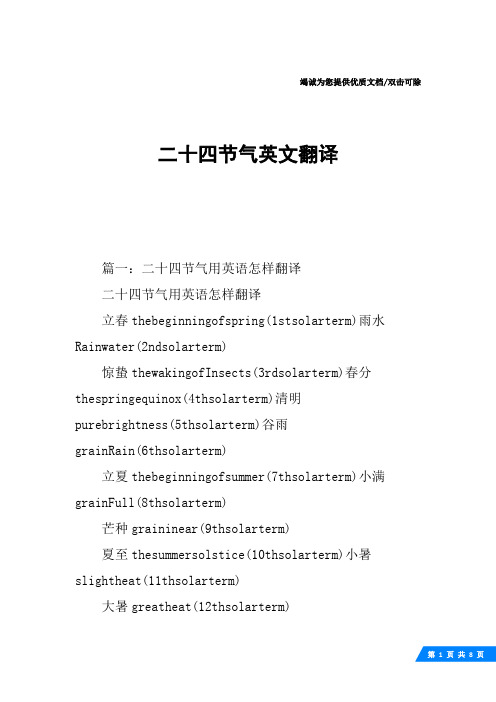
竭诚为您提供优质文档/双击可除二十四节气英文翻译篇一:二十四节气用英语怎样翻译二十四节气用英语怎样翻译立春thebeginningofspring(1stsolarterm)雨水Rainwater(2ndsolarterm)惊蛰thewakingofInsects(3rdsolarterm)春分thespringequinox(4thsolarterm)清明purebrightness(5thsolarterm)谷雨grainRain(6thsolarterm)立夏thebeginningofsummer(7thsolarterm)小满grainFull(8thsolarterm)芒种graininear(9thsolarterm)夏至thesummersolstice(10thsolarterm)小暑slightheat(11thsolarterm)大暑greatheat(12thsolarterm)立秋thebeginningofAutumn(13thsolarterm)处暑theLimitofheat(14thsolarterm)白露whiteDew(15thsolarterm)秋分theAutumnalequinox(16thsolarterm)寒露coldDew(17thsolarterm)霜降Frost′sdescent(18thsolarterm)立冬thebeginningofwinter(19thsolarterm)小雪slightsnow(20thsolarterm)大雪greatsnow(21stsolarterm)冬至thewintersolstice(22ndsolarterm)小寒slightcold(23rdsolarterm)大寒greatcold(24thsolarterm)篇二:二十四节气中英文对照二十四节气中英文对照二十四节气是中国古代订立的一种用来指导农事的补充历法,是中国古代汉族劳动人民长期经验的积累和智慧的结晶。
中国二十四节气英语介绍中国传统文化作文

中国二十四节气英语介绍中国传统文化作文The Traditional Chinese Twenty-Four Solar Terms: A Glimpse into the Rich Cultural HeritageThe ancient Chinese calendar, with its intricate system of twenty-four solar terms, offers a unique window into the profound cultural traditions of China. These solar terms, rooted in the rhythms of nature and the celestial movements, have been integral to the lives of the Chinese people for centuries, shaping their agricultural practices, festivals, and even their philosophical perspectives.At the heart of the twenty-four solar terms lies a deep understanding of the cyclical nature of the seasons and the delicate balance between Heaven and Earth. Each solar term, marked by the sun's passage through the zodiac, represents a distinct phase in the natural world, from the awakening of spring to the slumbering of winter. These transitions are not merely observed, but celebrated with reverence and rituals, reflecting the Chinese belief in the harmonious coexistence of humanity and the natural environment.One of the most prominent solar terms is the Vernal Equinox, known as Chunfen in Chinese. This event, marking the arrival of spring, iscelebrated with the Qingming Festival, a time for honoring one's ancestors and tending to their graves. The act of sweeping the tombs and leaving offerings not only pays respect to the departed but also symbolizes the renewal of life and the cyclical nature of existence.The Summer Solstice, or Xiazhi, is another significant solar term that holds deep cultural significance. During this time, the Chinese people engage in the Dragon Boat Festival, a vibrant celebration that commemorates the life and death of the poet Qu Yuan. The races of colorful dragon boats, the consumption of zongzi (glutinous rice dumplings), and the throwing of realgar wine into the water all hold profound symbolic meanings, connecting the people to their ancestral traditions and the rhythms of the natural world.As the year progresses, the solar terms continue to shape the cultural fabric of China. The Autumnal Equinox, or Qiufen, marks the arrival of the harvest season, a time of thanksgiving and reflection. Families gather to enjoy the Mid-Autumn Festival, savoring the delicate mooncakes and admiring the full moon, which is seen as a symbol of unity and harmony.The Winter Solstice, or Dongzhi, is celebrated as a time of renewal and the return of the sun. Families come together to prepare and enjoy the traditional dish of tangyuan, glutinous rice balls, whichsymbolize togetherness and the reunion of loved ones.Beyond the festivals and rituals, the twenty-four solar terms have also influenced the Chinese philosophy and approach to life. The concept of yin and yang, the delicate balance between opposing forces, is deeply intertwined with the cyclical nature of the solar terms. The understanding that change is constant, and that harmony is achieved through the embrace of both light and dark, has shaped the Chinese worldview and its approach to living in harmony with the natural world.Furthermore, the solar terms have also played a crucial role in the development of traditional Chinese medicine. The timing of certain treatments and the use of specific herbs are closely tied to the rhythms of the solar terms, reflecting the belief that the human body is intimately connected to the natural cycles of the earth.In conclusion, the twenty-four solar terms of the Chinese calendar are not merely a means of marking time but a profound expression of the country's rich cultural heritage. These intricate seasonal markers have shaped the festivals, rituals, philosophy, and even the medical practices of the Chinese people, serving as a testament to their deep reverence for the natural world and their desire to live in harmony with its rhythms. As the world increasingly grapples with the challenges of modernity, the wisdom embodied in the twenty-four solar terms offers a valuable perspective on the importance of maintaining a balanced and sustainable relationship with the environment.。
英语作文二十四节气
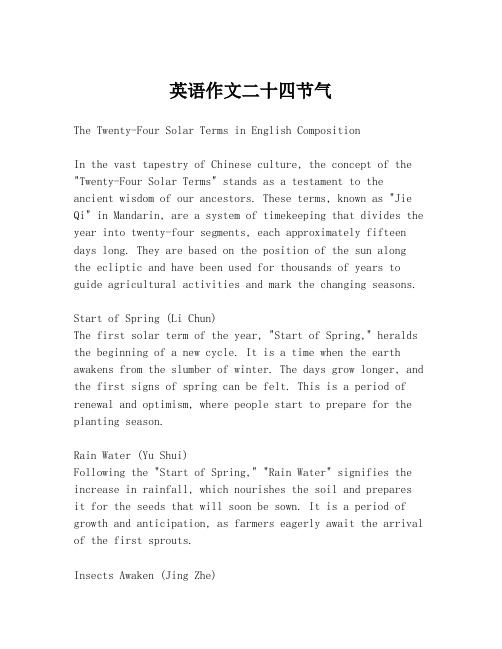
英语作文二十四节气The Twenty-Four Solar Terms in English CompositionIn the vast tapestry of Chinese culture, the concept of the "Twenty-Four Solar Terms" stands as a testament to the ancient wisdom of our ancestors. These terms, known as "Jie Qi" in Mandarin, are a system of timekeeping that divides the year into twenty-four segments, each approximately fifteen days long. They are based on the position of the sun along the ecliptic and have been used for thousands of years to guide agricultural activities and mark the changing seasons.Start of Spring (Li Chun)The first solar term of the year, "Start of Spring," heralds the beginning of a new cycle. It is a time when the earth awakens from the slumber of winter. The days grow longer, and the first signs of spring can be felt. This is a period of renewal and optimism, where people start to prepare for the planting season.Rain Water (Yu Shui)Following the "Start of Spring," "Rain Water" signifies the increase in rainfall, which nourishes the soil and preparesit for the seeds that will soon be sown. It is a period of growth and anticipation, as farmers eagerly await the arrival of the first sprouts.Insects Awaken (Jing Zhe)As the season progresses, "Insects Awaken" marks the time when the hibernating creatures of the earth begin to stir. The warming temperatures and increasing daylight bring life back to the fields and forests, symbolizing the awakening of nature.Grain Rain (Guang Yu)"Grain Rain" is a crucial period for agriculture, as it is named for the rain that is essential for the growth of grain crops. This is a time of intense activity in the fields, with farmers tending to their crops and ensuring they receive the necessary nourishment.Grain in Ear (Mang Zhong)"Grain in Ear" is a term that signifies the maturation of the grain. It is a time of harvest, where the fruits of the labor are reaped. The fields are golden with the promise of a bountiful yield.Summer Solstice (Xia Zhi)The longest day of the year, "Summer Solstice," marks the peak of summer. It is a time of intense heat and abundant sunlight, which is crucial for the growth of crops. Celebrations are held to honor the sun and its role in sustaining life.Start of Autumn (Li Qiu)As the seasons transition, "Start of Autumn" is a time of preparation for the harvest. The days begin to shorten, and the cooler temperatures signal the end of summer and the approach of autumn.White Dew (Bai Lu)"White Dew" is named for the dew that forms on the grass and leaves in the early morning. It is a time of crisp air and clear skies, a prelude to the cooler weather that autumn will bring.Cold Dew (Han Lu)"Cold Dew" marks the deepening of autumn, with the dew becoming colder and the leaves beginning to change color. It is a time of transition, as nature prepares for the coming of winter.Frost's Descent (Shuang Jiang)"Frost's Descent" is a term that signifies the first frosts of the season. It is a time of beauty, as the leaves turn vibrant shades of red and gold before they fall.Winter Solstice (Dong Zhi)The shortest day of the year, "Winter Solstice," marks the beginning of winter. It is a time of rest and reflection, as the days are short and the nights are long.Great Cold (Da Han)"Great Cold" is the last solar term of the year, a period of intense cold and preparation for the new year. It is a time of bundling up and staying warm, as the earth awaits the return of spring.These solar terms are not only a calendar for farmers but also a cultural heritage that has been passed down throughgenerations. They reflect the harmony between humans and nature, and the importance of living in sync with the cycles of the earth. In English composition, these terms can be used to explore themes of change, growth, and the beauty of the natural world.。
中国二十四节气英语介绍中国传统文化作文

The Chinese 24 Solar Terms: A Reflection ofTraditional CultureThe Chinese 24 Solar Terms, a unique system of agricultural timekeeping, is not only a practical tool for farmers but also a profound expression of Chinesetraditional culture. These terms, which divide the yearinto 24 equal segments based on the solar's annual path, reflect the harmonious relationship between humans and nature. Each term carries deep cultural and historical meanings, telling the story of China's agricultural heritage and philosophical wisdom.The 24 Solar Terms date back over 2,000 years to the Qin and Han dynasties, a time when the Chinese people were closely connected to the rhythms of nature. The terms were not only used to guide agricultural activities but also to understand and interpret the world around them. Each term has a specific name, often derived from nature's cycles and phenomena, such as "Spring Equinox," "Summer Solstice," and "Autumn Equinox." These names not only describe the weather or seasonal changes but also carry cultural and philosophical meanings.One of the most significant aspects of the 24 Solar Terms is its emphasis on harmony with nature. This harmony is reflected in the way the terms guide agricultural activities, such as planting, harvesting, and irrigation. By observing and understanding the natural cycles, farmers can maximize their yields and minimize the impact on the environment. This philosophy of harmony with nature is also present in other aspects of Chinese culture, such as Taoism and Confucianism, which emphasize living in harmony with the universe.The 24 Solar Terms are also a testament to the observational skills and wisdom of the ancient Chinese people. The accuracy with which these terms divide the year is remarkable, considering they were developed without modern scientific instruments. This shows the deep understanding and respect for nature that the ancient Chinese had, and it continues to inspire and inform people today.The cultural impact of the 24 Solar Terms extends beyond agriculture. Many traditional Chinese festivals and customs are tied to these terms. For example, the DragonBoat Festival, which falls on the fifth day of the fifth lunar month, corresponds to the Solar Term of "Plum Rain." This festival is marked by dragon boat races and the eating of zongzi, a traditional rice dish wrapped in bamboo leaves. These customs not only celebrate the harvest but also serve as a reminder of the deeper cultural meanings behind the Solar Terms.In conclusion, the Chinese 24 Solar Terms are not justa system of agricultural timekeeping; they are a profound expression of Chinese traditional culture. They reflect the harmonious relationship between humans and nature, the wisdom and observational skills of the ancient Chinese, and the deep cultural and historical meanings tied to each term. As we move forward in the modern world, it is important to remember the wisdom embedded in these terms and to continue to honor and preserve our rich cultural heritage.**中国二十四节气:传统文化的体现**中国二十四节气,这一独特的农业时间划分系统,不仅是农民实用的工具,更是中国传统文化深刻内涵的体现。
关于节气的英文作文
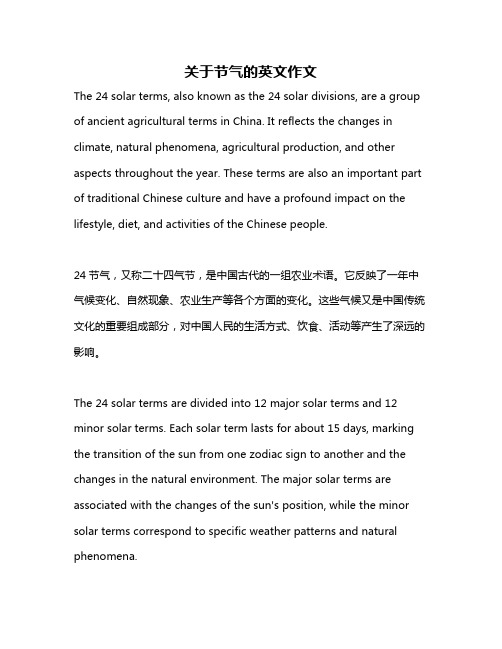
关于节气的英文作文The 24 solar terms, also known as the 24 solar divisions, are a group of ancient agricultural terms in China. It reflects the changes in climate, natural phenomena, agricultural production, and other aspects throughout the year. These terms are also an important part of traditional Chinese culture and have a profound impact on the lifestyle, diet, and activities of the Chinese people.24节气,又称二十四气节,是中国古代的一组农业术语。
它反映了一年中气候变化、自然现象、农业生产等各个方面的变化。
这些气候又是中国传统文化的重要组成部分,对中国人民的生活方式、饮食、活动等产生了深远的影响。
The 24 solar terms are divided into 12 major solar terms and 12 minor solar terms. Each solar term lasts for about 15 days, marking the transition of the sun from one zodiac sign to another and the changes in the natural environment. The major solar terms are associated with the changes of the sun's position, while the minor solar terms correspond to specific weather patterns and natural phenomena.二十四节气分为12个主要节气和12个次要节气。
二十四节气英语作文
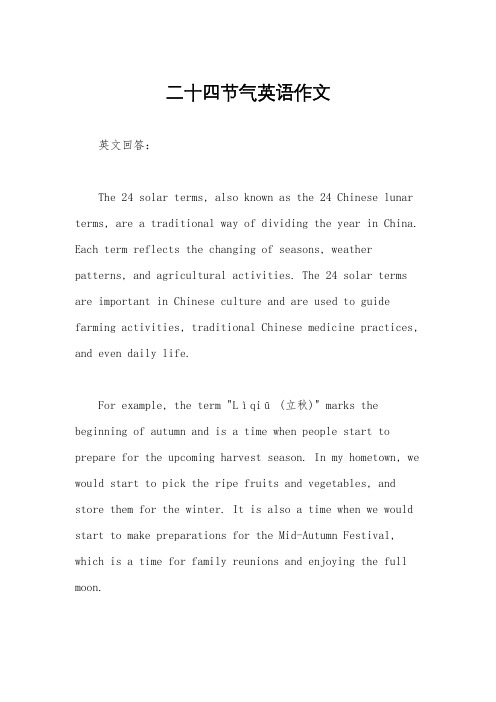
二十四节气英语作文英文回答:The 24 solar terms, also known as the 24 Chinese lunar terms, are a traditional way of dividing the year in China. Each term reflects the changing of seasons, weather patterns, and agricultural activities. The 24 solar terms are important in Chinese culture and are used to guide farming activities, traditional Chinese medicine practices, and even daily life.For example, the term "Lìqiū (立秋)" marks the beginning of autumn and is a time when people start to prepare for the upcoming harvest season. In my hometown, we would start to pick the ripe fruits and vegetables, and store them for the winter. It is also a time when we would start to make preparations for the Mid-Autumn Festival, which is a time for family reunions and enjoying the full moon.Another example is the term "Dàshǔ (大暑)" which signifies the hottest days of the year. During this time, people would take extra precautions to stay cool and hydrated. We would often say "Zhè shíjiān rè de bào,yào duō hē shuǐ, shǎo chū yīdiǎn" (这时间热得很,要多喝水,少出一点) which means "It's very hot at this time, drink more water and go out less."中文回答:二十四节气,也被称为二十四气,是中国传统的一种时间记法。
中国二十四节气英语作文

中国二十四节气英语作文(中英文版)Title: The Twenty-Four Solar Terms in ChinaThe Twenty-Four Solar Terms, an integral part of traditional Chinese agriculture, is a time division system that reflects the changes of seasons.It is not merely a calendar but also a philosophy of life, deeply rooted in the Chinese culture.标题:中国的二十四节气二十四节气是中国传统农业的重要组成部分,它是一个反映季节变化的时间划分系统。
它不仅仅是一个日历,更是一种深植于中国文化的生命哲学。
Spring begins with the term Lichun, when the sun reaches a specific position on the celestial sphere, marking the start of a new agricultural year.It"s a time of renewal and hope.春始于立春,当太阳到达天球上一个特定位置时,便标志着一个新的农业年的开始。
这是一个重生和希望的时节。
随着立春的到来,万物复苏,农民开始忙碌于田间,播种希望。
The term Insects Awaken signals the return of life, as bugs and creatures start to emerge from their winter slumber.随着立春的到来,万物复苏,农民开始忙碌于田间,播种希望。
惊蛰这一节气标志着生命的回归,因为虫子和生物开始从冬眠中苏醒。
二十四节气英语作文
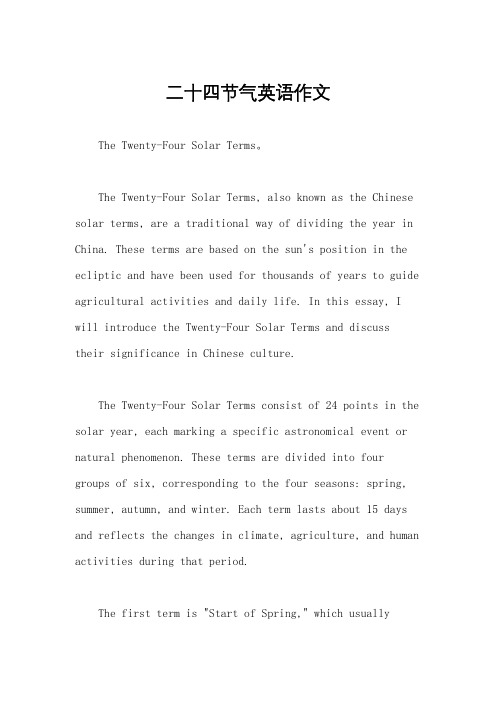
二十四节气英语作文The Twenty-Four Solar Terms。
The Twenty-Four Solar Terms, also known as the Chinese solar terms, are a traditional way of dividing the year in China. These terms are based on the sun's position in the ecliptic and have been used for thousands of years to guide agricultural activities and daily life. In this essay, I will introduce the Twenty-Four Solar Terms and discusstheir significance in Chinese culture.The Twenty-Four Solar Terms consist of 24 points in the solar year, each marking a specific astronomical event or natural phenomenon. These terms are divided into four groups of six, corresponding to the four seasons: spring, summer, autumn, and winter. Each term lasts about 15 days and reflects the changes in climate, agriculture, and human activities during that period.The first term is "Start of Spring," which usuallyfalls on February 4th or 5th. It marks the beginning of the agricultural year and signals the end of winter. As the weather gradually warms up, people start preparing for spring plowing and sowing. The second term, "Rain Water," signifies the increase in rainfall, which is crucial for the growth of crops.As we move into the summer season, the terms become more focused on the changes in weather and natural phenomena. "Grain Rain" is the last term of spring and indicates the arrival of the rainy season, providing ample water for the crops. "Summer Solstice" is the longest day of the year and marks the middle of summer. It is a timefor celebration and outdoor activities.The autumn terms are characterized by the harvest season and the changing colors of leaves. "Start of Autumn" signals the beginning of cool weather and the preparation for autumn harvest. "White Dew" refers to the dewdrops that resemble white jade on the grass, indicating the arrival of cooler temperatures. "Frost's Descent" marks the firstfrost of the year and the time to harvest crops that aresensitive to cold.Finally, the winter terms are associated with cold weather and the preparation for the upcoming spring. "Start of Winter" signifies the beginning of winter and the need to prepare for the cold months ahead. "Major Snow"indicates the arrival of heavy snowfall, which is essential for soil moisture and the storage of water resources. "Winter Solstice" is the shortest day of the year and marks the middle of winter.The Twenty-Four Solar Terms play a significant role in Chinese culture. They not only guide agriculturalactivities but also influence people's daily lives, traditional customs, and even diet. For example, during the "Start of Spring," people often eat dumplings to symbolize the arrival of a new year. "Qingming" is a festival that falls during the term "Clear and Bright," where people pay respects to their ancestors and enjoy outdoor activities.In conclusion, the Twenty-Four Solar Terms are an important part of Chinese culture and provide a unique wayof understanding and experiencing the changing seasons. They reflect the close relationship between humans and nature and guide various aspects of Chinese life. Understanding these terms helps us appreciate the rich cultural heritage of China and the wisdom of our ancestors in harmonizing with nature.。
二十四节气英文作文
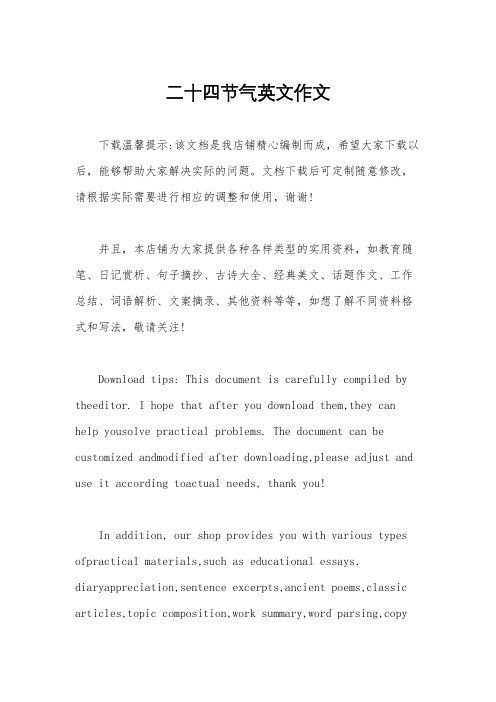
二十四节气英文作文下载温馨提示:该文档是我店铺精心编制而成,希望大家下载以后,能够帮助大家解决实际的问题。
文档下载后可定制随意修改,请根据实际需要进行相应的调整和使用,谢谢!并且,本店铺为大家提供各种各样类型的实用资料,如教育随笔、日记赏析、句子摘抄、古诗大全、经典美文、话题作文、工作总结、词语解析、文案摘录、其他资料等等,如想了解不同资料格式和写法,敬请关注!Download tips: This document is carefully compiled by theeditor. I hope that after you download them,they can help yousolve practical problems. The document can be customized andmodified after downloading,please adjust and use it according toactual needs, thank you!In addition, our shop provides you with various types ofpractical materials,such as educational essays, diaryappreciation,sentence excerpts,ancient poems,classic articles,topic composition,work summary,word parsing,copyexcerpts,other materials and so on,want to know different data formats andwriting methods,please pay attention!1. The Beginning of Spring。
It's the beginning of spring, and the weather isfinally starting to warm up. The days are getting longer, and the flowers are beginning to bloom. It's a time of renewal and growth, a fresh start after a long winter. I can feel the energy in the air, and it's contagious. It's time to shake off the winter blues and embrace the new season with open arms.2. The Rain Water。
用中英文介绍中国24节气的来历及意义作文
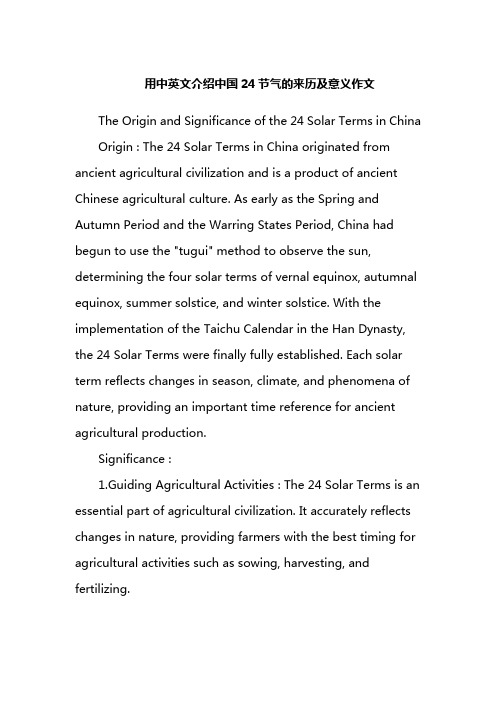
用中英文介绍中国24节气的来历及意义作文The Origin and Significance of the 24 Solar Terms in China Origin : The 24 Solar Terms in China originated from ancient agricultural civilization and is a product of ancient Chinese agricultural culture. As early as the Spring and Autumn Period and the Warring States Period, China had begun to use the "tugui" method to observe the sun, determining the four solar terms of vernal equinox, autumnal equinox, summer solstice, and winter solstice. With the implementation of the Taichu Calendar in the Han Dynasty, the 24 Solar Terms were finally fully established. Each solar term reflects changes in season, climate, and phenomena of nature, providing an important time reference for ancient agricultural production.Significance :1.Guiding Agricultural Activities : The 24 Solar Terms is an essential part of agricultural civilization. It accurately reflects changes in nature, providing farmers with the best timing for agricultural activities such as sowing, harvesting, and fertilizing.2.Promoting Cultural Exchange : As a part of traditional Chinese culture, the 24 Solar Terms has not only spread domestically but has also influenced other East Asian countries such as Japan and South Korea, promoting cultural exchange.3.Embodying Harmony between Man and Nature : The establishment of the 24 Solar Terms reflects the ancient Chinese respect and utilization of natural laws, exhibiting a harmonious symbiotic relationship between man and nature.翻译:中国24节气的来历及意义起源:中国24节气,源于古代农耕文明,是中国古代农耕文化的产物。
- 1、下载文档前请自行甄别文档内容的完整性,平台不提供额外的编辑、内容补充、找答案等附加服务。
- 2、"仅部分预览"的文档,不可在线预览部分如存在完整性等问题,可反馈申请退款(可完整预览的文档不适用该条件!)。
- 3、如文档侵犯您的权益,请联系客服反馈,我们会尽快为您处理(人工客服工作时间:9:00-18:30)。
中国民俗-二十四节气-文化
中文:
二十四节气(the 24 solar terms)是根据太阳在一年中的位置变化确定的。
二十四节气首先在中国使用,现在被世界上很多国家采用。
几千年前,中国确定了二十四节气用以指导农业生产。
与各个节气相对应的季节性节日、特定食物、文化仪式、家庭聚会乃至养生之道也可以反映出丰富的中国文化。
其实,了解中国节气的历史和传承有助于深入了解中国的过去和现在。
语言要点:
determine; family gathering; healthy living tip; correspond with; as a matter of fact; facilitate
译文:
The 24 solar terms are determined by changes in the sun’s position during the year. They were first used in China, and now are followed in many other parts of the world. In China, the 24 solar terms were created thousands of years ago to guide agricultural production. They also reflect China’s rich history through the seasonal festivals, special
foods, cultural ceremonies, family gatherings and even healthy living tips that correspond with each solar term. As a matter of fact, to learn about the history and continuing celebrations of China’s solar terms facilitates a deeper understanding of China’s past and present.。
